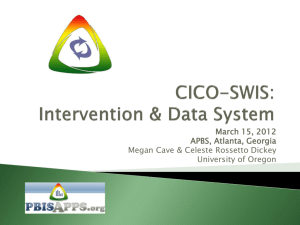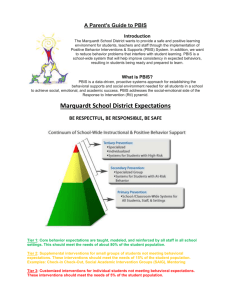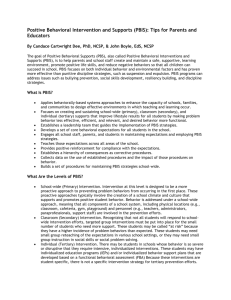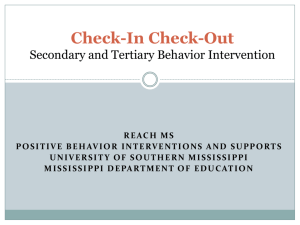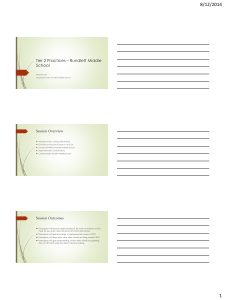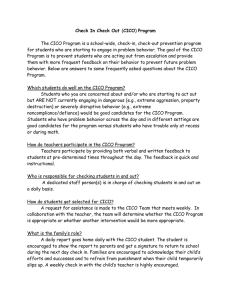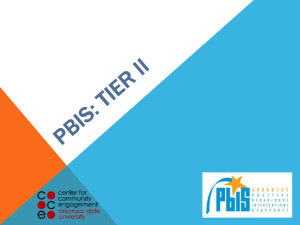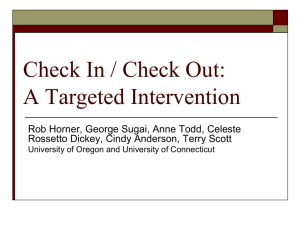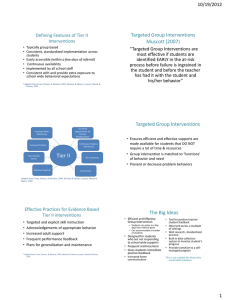System Response Tool - NYS PBIS Technical Assistance Center
advertisement
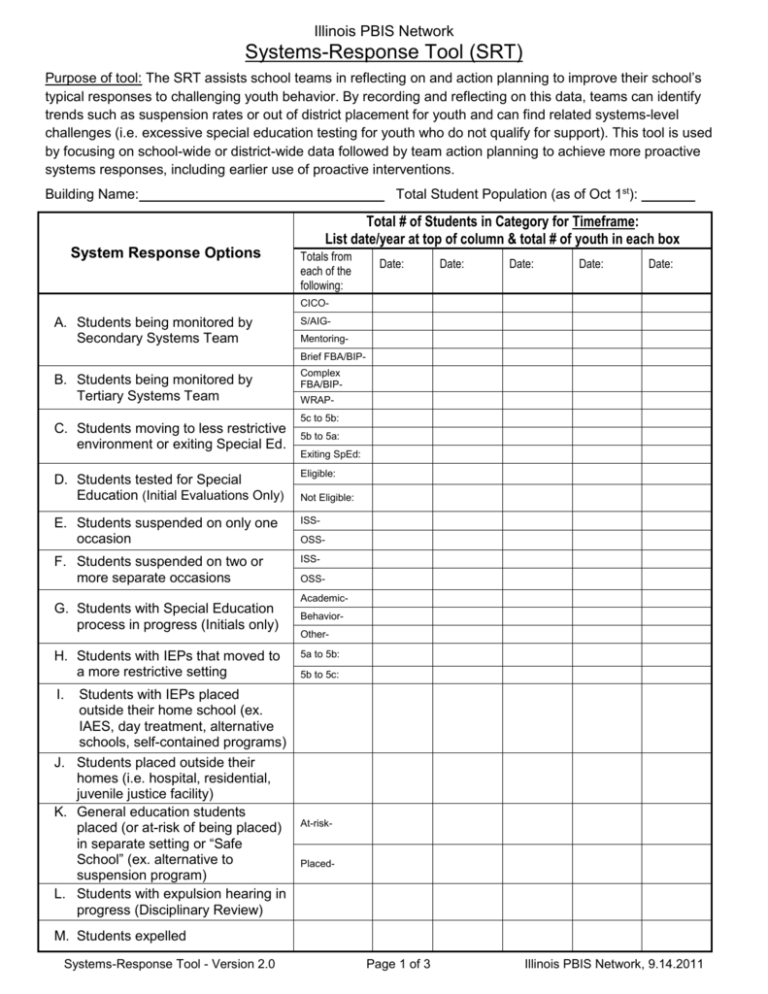
Illinois PBIS Network Systems-Response Tool (SRT) Purpose of tool: The SRT assists school teams in reflecting on and action planning to improve their school’s typical responses to challenging youth behavior. By recording and reflecting on this data, teams can identify trends such as suspension rates or out of district placement for youth and can find related systems-level challenges (i.e. excessive special education testing for youth who do not qualify for support). This tool is used by focusing on school-wide or district-wide data followed by team action planning to achieve more proactive systems responses, including earlier use of proactive interventions. ___ Total Student Population (as of Oct 1st): _______ Building Name: Total # of Students in Category for Timeframe: List date/year at top of column & total # of youth in each box System Response Options Totals from each of the following: Date: Date: Date: Date: Date: CICO- A. Students being monitored by Secondary Systems Team S/AIGMentoringBrief FBA/BIP- B. Students being monitored by Tertiary Systems Team C. Students moving to less restrictive environment or exiting Special Ed. Complex FBA/BIPWRAP5c to 5b: 5b to 5a: Exiting SpEd: D. Students tested for Special Education (Initial Evaluations Only) Eligible: E. Students suspended on only one occasion ISS- F. Students suspended on two or more separate occasions ISS- G. Students with Special Education process in progress (Initials only) H. Students with IEPs that moved to a more restrictive setting Students with IEPs placed outside their home school (ex. IAES, day treatment, alternative schools, self-contained programs) J. Students placed outside their homes (i.e. hospital, residential, juvenile justice facility) K. General education students placed (or at-risk of being placed) in separate setting or “Safe School” (ex. alternative to suspension program) L. Students with expulsion hearing in progress (Disciplinary Review) Not Eligible: OSS- OSSAcademicBehaviorOther5a to 5b: 5b to 5c: I. At-risk- Placed- M. Students expelled Systems-Response Tool - Version 2.0 Page 1 of 3 Illinois PBIS Network, 9.14.2011 Illinois PBIS Network Systems-Response Tool (SRT) Directions Tier 2/3 Internal Coach or Administrator gathers data points listed on SRT and/or organizes overall efforts to have the data brought to the meeting where this tool will be discussed. SRT should be used at least quarterly with Tertiary Systems Team members and building-level administrators including Lead Sp.Ed Teacher/Chair. Data should be discussed in aggregate, without naming individual youth, however there may be times youth are identified for Tier 3 support because of their contribution to data on SRT. When this occurs, youth names will quickly be listed and given to the School Wraparound Coordinator to begin support; no individual youth planning should occur at this meeting. Key A. Secondary Interventions CICO – Check-in Check-out: Students check-in with designated CICO Facilitator/s before the beginning and at the end of each school-day to receive positive contact, pre-corrects, reminders of school-wide expectations and, if needed, basic school supplies. At the end of each class period, classroom teachers provide youth positive behavioral feedback, based on the school-wide expectations, on a Daily Progress Report Card (DPR). S/AIG – Social/Academic Instructional Groups: Youth are supported in a small group for direct instruction of school-wide expectations and/or replacement behaviors, including structured practice and direct behavioral feedback. Intervention leads to generalization most effectively when youth are also supported by CICO, where classroom teachers provide youth positive behavioral feedback on a DPR related to their transference of newly learned skills taught during group. Individualized CICO, Groups & Mentoring: Individualized CICO has most of the same features as the generic CICO but includes some fairly simple individualizations (i.e. change in location of CICO, addition of more Check-ins, etc.) without creating individual student goals or goal lines (which would only come after an FBA/BIP). Mentoring involves one adult meeting with one or more students at a time, one or more times per week, to provide pre-corrects and a positive connection with the school through a supportive relationship. Brief FBA/BIP – Functional Behavior Assessment/Behavior Intervention Plan: Brief behavior intervention plans are developed for one student at a time, based on a brief assessment of function of behavior by the Tier 2 generic problem-solving team. Brief Tier 2 behavior intervention plans address only one behavior, typically only in one setting. Interventions are chosen or designed based on youth’s strengths, assessed function of behavior and skills-deficits. B. Tertiary Interventions Complex FBA/BIP – An individualized team is created specifically for one youth at a time (includes family, community, and relevant school-based adults) to assess youth strengths, skills-deficits, and function of behavior, as well as to develop a comprehensive intervention plan. Plan addresses multiple settings and/or behaviors. Wraparound (Wrap) – An identified team facilitator engages a child and their family in developing a unique team to support youth success at home, school and in the community. Facilitator arranges for frequent team meetings to develop, refine, and progress-monitor interventions and supports that address multiple life domains across settings (home, school, and community). Plans include highly individualized interventions and supports designed based on youth strengths and big needs (quality of life indicators) identified by youth, family, and other team members. Systems-Response Tool - Version 2.0 Page 2 of 3 Illinois PBIS Network, 9.14.2011 Illinois PBIS Network Systems-Response Tool (SRT) C. Special Education Process Academic – Special education evaluation process initiated due to primarily academic/learning challenges Behavior – Special education evaluation process initiated due to primarily behavioral/social challenges D. Special Education Evaluation Results Eligible – Student qualifies for Special Education services Not Eligible – Student’s risk is not high enough to qualify for Special Education services E-F. Suspensions ISS – In-School Suspension OSS – Out-of-School Suspension G-H. Educational Environment 5a – Number of students with IEPs removed from regular classroom less than 21% of the day 5b – Number of students with IEPs removed from regular class greater than 60% of the day 5c – Number of students with IEPs served in public or private separate schools, residential environments, or homebound or hospital placements J. Special Education Setting In District – Student’s classroom not in assigned home school based on residency, but still within home school district Out of District – Student’s classroom exists out of the assigned home school district L. Separate Setting Placement At-risk – Student is at risk of being placed in a separate setting Placed – Student has already been placed in a separate setting Systems-Response Tool - Version 2.0 Page 3 of 3 Illinois PBIS Network, 9.14.2011


